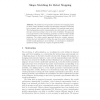Free Online Productivity Tools
i2Speak
i2Symbol
i2OCR
iTex2Img
iWeb2Print
iWeb2Shot
i2Type
iPdf2Split
iPdf2Merge
i2Bopomofo
i2Arabic
i2Style
i2Image
i2PDF
iLatex2Rtf
Sci2ools
PRICAI
2004
Springer
2004
Springer
Shape Matching for Robot Mapping
We present a novel geometric model for robot mapping based on shape. Shape similarity measure and matching techniques originating from computer vision are specially redesigned for matching range scans. The fundamental geometric representation is a structural one, polygonal lines are ordered according to the cyclic order of visibility. This approach is an improvement of the underlying geometric models of today’s SLAM implementations, where shape matching allows us to disregard pose estimations. The object-centered approach allows for compact representations that are well-suited to bridge the gap from metric information n path planning to more abstract, i.e. topological or qualitative spatial knowledge desired in complex navigational tasks. 1 Motivation The problems of self-localization, i.e. localizing the robot within its internal map, and robot mapping, i.e. constructing the internal map autonomously, are of high importance to the field of mobile robotics [16]. Coping with unknown ...
Artificial Intelligence | Fundamental Geometric Representation | Geometric Models | Geometric Representation | PRICAI 2004 |
| Added | 02 Jul 2010 |
| Updated | 02 Jul 2010 |
| Type | Conference |
| Year | 2004 |
| Where | PRICAI |
| Authors | Diedrich Wolter, Longin Jan Latecki |
Comments (0)

